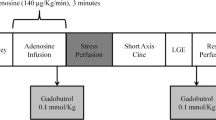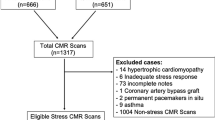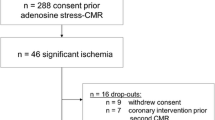Abstract
Aims
This prospective study was designed to determine the diagnostic value of adenosine stress cardiac magnetic resonance imaging (CMRI) in patients referred to elective coronary angiography.
Methods and results
Myocardial perfusion measurements at rest and adenosine stress were performed in 141 patients (105 men, 36 women, mean age 63.4 years) at 1.5 T with a Turbo Flash sequence. Stress-induced perfusion deficits were correlated to angiographic stenoses ≥75%. The overall sensitivity for CMRI depicting coronary artery disease (CAD) with relevant stenoses was 90.4%, the specificity was 77.4%, the positive predictive value was 85.9%, the negative predictive value was 84.2% and the accuracy 85.2%. Subgroup analysis was performed for 3-vessel disease (n = 44, sensitivity 92.3%, specificity 75.0%), 2-vessel disease (n = 43, sensitivity 92.6%, specificity 92.9%), 1-vessel disease (n = 27, sensitivity 93.1%, specificity 71.4%) and patients without CAD (n = 27, specificity 70.4%) as well as for patients with prior myocardial infarction (n = 44, sensitivity 92.9%, specificity 86.7%), prior coronary artery bypass surgery (n = 21, sensitivity 88.2%, specificity 66.7%), prior coronary interventions (n = 88, sensitivity 91.9%, specificity 75.0%), or diabetics (n = 27, sensitivity 90.5%, specificity 83.3%).
Conclusion
Our study shows that stress perfusion CMRI can accurately predict relevant CAD and contributes to the identification of hemodynamic relevant stenoses in patients scheduled for coronary angiography.


Similar content being viewed by others
References
Al-Saadi N, Nagel E, Gross M, Bornstedt A, Schnackenburg B, Klein C, Klimek W, Oswald H, Fleck E (2000) Noninvasive detection of myocardial ischemia from perfusion reserve based on cardiovascular magnetic resonance. Circulation 101(12):1379–1383
Al-Saadi N, Nagel E, Gross M, Schnackenburg B, Paetsch I, Klein C, Fleck E (2000) Improvement of myocardial perfusion reserve early after coronary intervention: assessment with cardiac magnetic resonance imaging. J Am Coll Cardiol 36(5):1557–1564
Benoit T, Vivegnis D, Lahiri A, Itti R, Braat S, Rigo P (1996) Tomographic myocardial imaging with technetium-99m tetrofosmin. Comparison with tetrofosmin and thallium planar imaging and with angiography. Eur Heart J 17(4):635–642
Cerqueira MD, Weissman NJ, Dilsizian V, Jacobs AK, Kaul S, Laskey WK, Pennell DJ, Rumberger JA, Ryan T, Verani MS (2002) Standardized myocardial segmentation and nomenclature for tomographic imaging of the heart. A statement for healthcare professionals from the Cardiac Imaging Committee of the Council on Clinical Cardiology of the American Heart Association. Int J Cardiovasc Imaging 18(1):539–542
Cook S, Walker A, Hugli O, Togni M, Meier B (2007) Percutaneous coronary interventions in Europe: prevalence, numerical estimates, and projections based on data up to 2004. Clin Res Cardiol 96(6):375–382
Cullen JH, Horsfield MA, Reek CR, Cherryman GR, Barnett DB, Samani NJ (1999) A myocardial perfusion reserve index in humans using first-pass contrast-enhanced magnetic resonance imaging. J Am Coll Cardiol 33(5):1386–1394
Fenchel M, Helber U, Kramer U, Stauder NI, Franow A, Claussen CD, Miller S (2005) Detection of regional myocardial perfusion deficit using rest and stress perfusion MRI: a feasibility study. AJR Am J Roentgenol 185(3):627–635
Hombach V, Merkle N, Kestler HA, Torzewski J, Kochs M, Marx N, Nusser T, Burgstahler C, Rasche V, Bernhardt P, Kunze M, Wohrle J (2008) Characterization of patients with acute chest pain using cardiac magnetic resonance imaging. Clin Res Cardiol 30 May 2008 [Epub ahead of print]
Ingkanisorn WP, Kwong RY, Bohme NS, Geller NL, Rhoads KL, Dyke CK, Paterson DI, Syed MA, Aletras AH, Arai AE (2006) Prognosis of negative adenosine stress magnetic resonance in patients presenting to an emergency department with chest pain. J Am Coll Cardiol 47(7):1427–1432
Jerosch-Herold M, Seethamraju RT, Swingen CM, Wilke NM, Stillman AE (2004) Analysis of myocardial perfusion MRI. J Magn Reson Imaging 19(6):758–770
Jerosch-Herold M, Wilke N (1997) MR first pass imaging: quantitative assessment of transmural perfusion and collateral flow. Int J Card Imaging 13(3):205–218
Klem I, Heitner JF, Shah DJ, Sketch MH Jr, Behar V, Weinsaft J, Cawley P, Parker M, Elliott M, Judd RM, Kim RJ (2006) Improved detection of coronary artery disease by stress perfusion cardiovascular magnetic resonance with the use of delayed enhancement infarction imaging. J Am Coll Cardiol 47(8):1630–1638
Klocke FJ, Simonetti OP, Judd RM, Kim RJ, Harris KR, Hedjbeli S, Fieno DS, Miller S, Chen V, Parker MA (2001) Limits of detection of regional differences in vasodilated flow in viable myocardium by first-pass magnetic resonance perfusion imaging. Circulation 104(20):2412–2416
Lauerma K, Virtanen KS, Sipila LM, Hekali P, Aronen HJ (1997) Multislice MRI in assessment of myocardial perfusion in patients with single-vessel proximal left anterior descending coronary artery disease before and after revascularization. Circulation 96(9):2859–2867
Matheijssen NA, Louwerenburg HW, van Rugge FP, Arens RP, Kauer B, de Roos A, van der Wall EE (1996) Comparison of ultrafast dipyridamole magnetic resonance imaging with dipyridamole SestaMIBI SPECT for detection of perfusion abnormalities in patients with one-vessel coronary artery disease: assessment by quantitative model fitting. Magn Reson Med 35(2):221–228
Nagel E, Klein C, Paetsch I, Hettwer S, Schnackenburg B, Wegscheider K, Fleck E (2003) Magnetic resonance perfusion measurements for the noninvasive detection of coronary artery disease. Circulation 108(4):432–437
Paetsch I, Foll D, Langreck H, Herkommer B, Klein C, Schalla S, Fleck E, Nagel E (2004) Myocardial perfusion imaging using OMNISCAN: a dose finding study for visual assessment of stress-induced regional perfusion abnormalities. J Cardiovasc Magn Reson 6(4):803–809
Pilz G, Bernhardt P, Harrer E, Klos M, Hofling B (2008) Cardiac magnetic resonance imaging: an essential diagnostic aid in suspected myocardial re-infarction in a 40 year old woman. Clin Res Cardiol 97(4):280–283
Pilz G, Bernhardt P, Klos M, Ali E, Wild M, Hofling B (2006) Clinical implication of adenosine-stress cardiac magnetic resonance imaging as potential gatekeeper prior to invasive examination in patients with AHA/ACC class II indication for coronary angiography. Clin Res Cardiol 95(10):531–538
Plein S, Radjenovic A, Ridgway JP, Barmby D, Greenwood JP, Ball SG, Sivananthan MU (2005) Coronary artery disease: myocardial perfusion MR imaging with sensitivity encoding versus conventional angiography. Radiology 235(2):423–430
Rieber J, Huber A, Erhard I, Mueller S, Schweyer M, Koenig A, Schiele TM, Theisen K, Siebert U, Schoenberg SO, Reiser M, Klauss V (2006) Cardiac magnetic resonance perfusion imaging for the functional assessment of coronary artery disease: a comparison with coronary angiography and fractional flow reserve. Eur Heart J 27(12):1465–1471
Schwitter J (2006) Myocardial perfusion imaging by cardiac magnetic resonance. J Nucl Cardiol 13(6):841–854
Schwitter J, Nanz D, Kneifel S, Bertschinger K, Buchi M, Knusel PR, Marincek B, Luscher TF, von Schulthess GK (2001) Assessment of myocardial perfusion in coronary artery disease by magnetic resonance: a comparison with positron emission tomography and coronary angiography. Circulation 103(18):2230–2235
Schwitter J, Wacker CM, van Rossum AC, Lombardi M, Al-Saadi N, Ahlstrom H, Dill T, Larsson HB, Flamm SD, Marquardt M, Johansson L (2008) MR-IMPACT: comparison of perfusion-cardiac magnetic resonance with single-photon emission computed tomography for the detection of coronary artery disease in a multicentre, multivendor, randomized trial. Eur Heart J 29(4):480–489
Wagner A, Mahrholdt H, Holly TA, Elliott MD, Regenfus M, Parker M, Klocke FJ, Bonow RO, Kim RJ, Judd RM (2003) Contrast-enhanced MRI and routine single photon emission computed tomography (SPECT) perfusion imaging for detection of subendocardial myocardial infarcts: an imaging study. Lancet 361(9355):374–379
Wilke N, Jerosch-Herold M, Wang Y, Huang Y, Christensen BV, Stillman AE, Ugurbil K, McDonald K, Wilson RF (1997) Myocardial perfusion reserve: assessment with multisection, quantitative, first-pass MR imaging. Radiology 204(2):373–384
Author information
Authors and Affiliations
Corresponding author
Additional information
C. Doesch and A. Seeger have equally contributed to this publication.
Rights and permissions
About this article
Cite this article
Doesch, C., Seeger, A., Hoevelborn, T. et al. Adenosine stress cardiac magnetic resonance imaging for the assessment of ischemic heart disease. Clin Res Cardiol 97, 905–912 (2008). https://doi.org/10.1007/s00392-008-0708-z
Received:
Accepted:
Published:
Issue Date:
DOI: https://doi.org/10.1007/s00392-008-0708-z




